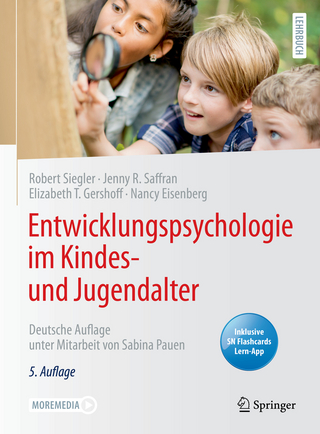
Thinking Critically About Child Development
SAGE Publications Inc (Verlag)
978-1-4833-7009-5 (ISBN)
- Titel erscheint in neuer Auflage
- Artikel merken
In the updated Third Edition of the previously titled Child Development: Myths and Misunderstandings, Jean Mercer offers 59 essays that confront popular misconceptions and fallacies about the field. Intriguing vignettes and critical thinking questions frame each essay, encouraging readers to think like social scientists and become better consumers of media messages and anecdotal stories. Timely topics and DSM-5 references make the book an engaging supplement for both chronologically and topically arranged child development texts.
Acknowledgments
About the Author
Introduction
Critical Thinking
What Is Critical Thinking?
How Do You Think Critically?
Fallacies to Watch for When Studying Child Development
Other Fallacies in Discussions of Child Development
Claims About Child Development
Types of Mistaken Claims
"Seductive Ideas"
Why Is It All So Complicated?
Understanding Basic Facts
Variations on the Development Theme
Examining the Evidence: Recognizing That a Belief May Be Mistaken
Sources of Information: Safe or Sorry?
The Work Ahead
Part I: Genetics and Prenatal Life
Claim 1: Genetic factors play such a strong role in human development that genes alone can determine certain human behavioral characteristics.
Claim 2: Although prematurely born babies are smaller than most and may need special medical care, the babies and their parents instinctively know how to interact with each other.
Claim 3: If a child’s problem is genetically caused, the problem will be present at birth and will stay the same throughout life.
Claim 4: Unborn babies are not influenced much by the environment outside the mother’s body.
Claim 5: As the date when her child will be born gets closer, a mother-to-be needs to be more careful about alcohol and drugs because the risk of birth defects increases throughout pregnancy.
Claim 6: Assisted reproductive technologies (ART) offer reliable ways for couples to have healthy children in spite of fertility problems.
Claim 7: Genetic relationships are a powerful factor in social and emotional interactions, so people recognize and are attracted to blood relatives even if they have never met them before.
Claim 8: Babies work hard to be born.
Claim 9: When a baby has genetic problems, there are no pre- or postnatal methods for treatment.
Claim 10: Except for their reproductive organs, there are no differences between boy and girl babies before or soon after birth. Gender differences occur as a result of different experiences for boys and girls.
Part II: Infants and Toddlers
Claim 11: Parents need to have contact with their babies right after birth so that they can bond with them.
Claim 12: Babies are born with emotional attachments to their mothers and can recognize their mothers at once.
Claim 13 : When mothers of young babies are depressed, the problem is caused by the changes in hormones they experience after the birth.
Claim 14: It’s been proven that it’s always better for parentless children to be placed in foster care rather than in orphanages or other institutions.
Claim 15: A baby’s sleeping position can cause or prevent sudden infant death syndrome.
Claim 16: Parents should not talk baby talk to their children because this slows their language development.
Claim 17: Being exposed to two different languages is confusing for babies and interferes with normal language development.
Claim 18: It’s a problem, and probably means autism, if babies don’t make eye contact in the first few weeks of life.
Claim 19: It’s harmful to preschoolers’ psychological development if they make overnight visits to estranged parents.
Claim 20: Toddlers drop food on the floor because they want to make their parents angry.
Claim 21: It is important for parents to work with babies and teach them how to walk.
Claim 22: It is a good thing for an infant or a toddler to have experience with many caregivers, not just one or two.
Claim 23: Screen devices provide excellent resources for encouraging infants’ and toddlers’ mental development.
Claim 24: Parents who were abused as children are likely to abuse their own children.
Part III: Preschoolers
Claim 25: Having kids listen to Mozart makes them smart.
Claim 26: The time between birth and age 3 years is the most important period of development and learning in a person’s life.
Claim 27: Children need to develop basic trust and show it by their confidence in other people.
Claim 28: If a child is able to complete a task with an adult present, he or she is able to do it alone.
Claim 29: Preschoolers who hold their breath when angry are trying to upset their parents and get their own way.
Claim 30: Vaccines and heavy metals cause autism.
Claim 31: Autism rates are rising rapidly, especially in certain parts of the country, so something must be happening to cause more cases of this serious developmental problem.
Claim 32: Preschool children who lie are developing along dangerous lines and need to be corrected severely in order to stop this bad behavior.
Claim 33: Preschoolers who try to bargain with their parents really want to manipulate and control adults, and they should not be allowed to negotiate.
Claim 34: A young child can tell when someone is just teasing.
Claim 35: Children with attachment disorders must be treated very sternly and differently from typically developing children-- even in ways that are ordinarily considered abusive.
Claim 36: Spanking should never be used to discipline a child, because it is ineffective and causes children to model the aggression they experience.
Part IV: School-Age Children
Claim 37: Girls who get their first period early are also likely to mature quickly in other ways.
Claim 38: Children have different learning styles, depending on whether they are left brained or right brained.
Claim 39: It’s healthy for children to be a little on the chubby side.
Claim 40: Birth order is an important factor that determines children’s intelligence and personality.
Claim 41: When a child is mentally ill, any psychological treatment is better than no treatment.
Claim 42: Bullying is a natural behavior of children, and there′s nothing you can do to stop it.
Claim 43: Sugar is a major cause of hyperactive behavior.
Claim 44: Adopted children have many more social and emotional development problems than do nonadopted children.
Claim 45: If a child is sexually molested, he or she will probably repress the memory.
Part V: Adolescents
Claim 46: Regular experience of shared family meals is critical for children’s academic and behavioral development.
Claim 47: Children are more likely to become delinquent if their fathers are absent or uninvolved.
Claim 48: Violent television programs and video games cause increased aggressive behavior.
Claim 49: If parents are not strict enough, children will behave badly and may become criminals.
Claim 50: Marijuana use by adolescents causes long-term problems in brain and cognitive functioning.
Claim 51: High self-esteem makes children perform better in school.
Claim 52: Single-sex schools give better outcomes of academic achievement than do coeducational schools.
Claim 53: The DARE program is an effective way to prevent children and adolescents from dealing or using drugs.
Claim 54: Children and adolescents learn bad behavior from their peers.
Claim 55: Young teenagers should be tried and sentenced as adults if they commit serious crimes.
Claim 56: Adolescence is an emotionally dangerous time when teenagers are likely to attempt or commit suicide.
Claim 57: Punishment is an effective way of changing children’s and adolescents’ undesirable behaviors.
Claim 58: Children are reaching puberty earlier with each generation.
Claim 59: Psychological treatments like “conversion therapy” can change a person’s same-sex orientation to a heterosexual orientation.
Afterthoughts
Index
| Verlagsort | Thousand Oaks |
|---|---|
| Sprache | englisch |
| Maße | 152 x 228 mm |
| Gewicht | 490 g |
| Themenwelt | Geisteswissenschaften ► Psychologie ► Entwicklungspsychologie |
| Sozialwissenschaften ► Pädagogik ► Sozialpädagogik | |
| Sozialwissenschaften ► Soziologie | |
| ISBN-10 | 1-4833-7009-7 / 1483370097 |
| ISBN-13 | 978-1-4833-7009-5 / 9781483370095 |
| Zustand | Neuware |
| Haben Sie eine Frage zum Produkt? |
aus dem Bereich



